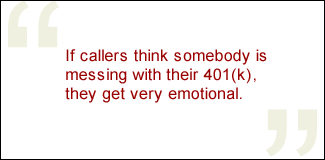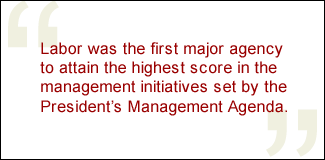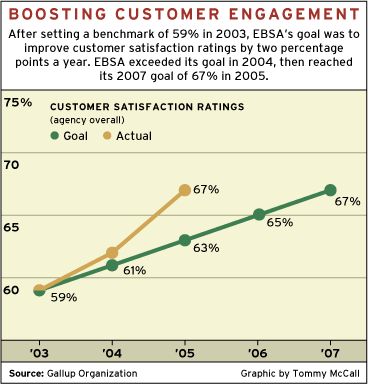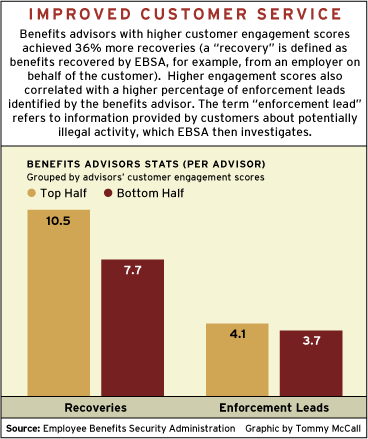If the United States were a commercial entity, the Constitution would be its strategic plan. It lays out the goals and policies of the organization and details the responsibilities and requirements for stakeholders. The mission statement is found in the preamble, which notes justice, tranquility, defense, welfare, and liberty as the ultimate outcomes for this enterprise. As strategic plans go, it's brilliant. It doesn't, however, make any mention of satisfying its customers: the citizens it exists to serve.
Though people may grumble about the un-businesslike operations of government, they probably shouldn't -- it really isn't a business. And yet the U.S. government has been moving toward treating its operations like a business and its citizens as customers.
 |
Performance initiatives accelerated when Congress passed the Government Performance and Results Act of 1993 (GPRA). This act mandated that each federal agency develop a strategic plan with outcome-related goals and objectives, develop annual performance plans with output- and outcome-related goals, and report annually to Congress on its progress toward achieving its goals and objectives. Among other things -- including inspiring the confidence of Americans in their federal agencies -- GPRA was meant to "improve federal program effectiveness and public accountability by promoting a new focus on results, service quality, and customer satisfaction."
Initiatives within the executive branch gained momentum in 2001 with the launch of the President's Management Agenda, which stressed performance and results in government. A key component of this agenda was the implementation of a balanced scorecard for government, which tracked agency progress toward meeting government-wide management initiatives for managing personnel, outsourcing certain functions, improving financial management, and implementing electronic government and performance-based budgeting. This was followed in 2002 by the development of the Program Assessment Rating Tool (PART). The Program Assessment Rating Tool (PART) was implemented to elicit and measure specific government agency outcomes and whether or not agencies were reaching them -- and those measurements were used to inform funding decisions.
Doing their PART
One of the agencies that moved quickly to incorporate these two initiatives into its mission was the Department of Labor, which comprises many offices and agencies, some of which perhaps are best known to the people who need them. Among these is the Employee Benefits Security Administration (EBSA), which regulates the operation of private-employer-provided retirement and health plans, as well as other employee benefit plans. In addition to enforcing the laws governing these plans, EBSA maintains a program dedicated to "educating and assisting the 150 million Americans covered by the 730,000 retirement plans and six million private health and welfare plans," according to the Customer Service Commitment statement posted on its Web site (www.dol.gov/ebsa/).
EBSA employs customer-facing staff, called benefits advisors, in 11 offices across the country. These highly trained advisors -- lawyers, accountants, and financial services experts -- respond to a wide variety of benefits questions. People call EBSA when they have trouble collecting their pensions, when they don't understand how COBRA works, when they have questions about 401(k) payouts, and the like.
The majority of the people who contact EBSA have a question that needs answering. Often, these inquiries involve complex issues about the laws, and they require time and expertise to handle properly. Customers also contact EBSA with problems that the agency is able to resolve by facilitating a resolution between the parties informally. In addition, some of the inquiries warrant more aggressive government intervention, such as an investigation. Whatever the case, people who need EBSA's help are concerned about money, and they're usually quite worried.
"People's retirement funds and their healthcare plans -- those are highly emotional subjects," says Alison Simon, Ph.D., a performance measurement expert with Gallup's government group. "If you think somebody is messing with your 401(k), or all of a sudden you're not getting the retirement checks that you were promised for the last thirty-five years, it's tough. Callers get very emotional."
This kind of emotion requires EBSA employees to be uniquely sensitive to the needs of the people they help -- they must provide what a business would call customer service. And EBSA has done just that. In a few short years, the agency has changed from being a repository of information and legal action to a customer-focused organization; its goal is to become a leader in customer engagement in government.
But before it could even start, EBSA had to find a way to define, analyze, and measure customer satisfaction, then demonstrate that its methods would work. Just determining what customer satisfaction meant to its clientele was no small trick. What's more, to measure customer satisfaction, EBSA had to demonstrate that a lack of business is a good thing -- that great customer service means EBSA probably won't hear from its customers again.
Getting down to business
EBSA put a lot of effort into making sure it was doing a good job, long before it was required to do so. "We used a timeliness measure for a number of years [measuring how quickly EBSA responded to requests]," says Terri Thomas, an EBSA senior program analyst. "Then we decided to measure our performance by the amount of benefit recoveries [the dollar value of employee benefits that were rightly due to the employee, which EBSA helps reclaim] we achieved. However, since only a portion of our workload involves benefit recoveries, that metric didn't provide a complete picture of our performance."
EBSA's first step toward developing a customer satisfaction metric wasn't entirely satisfactory. In 2000, EBSA participated in the University of Michigan's American Customer Satisfaction Index (ACSI) but didn't get the results it had hoped for.
 |
"The ACSI ranking didn't give EBSA any way to address customer service problems," says Simon. "ACSI only gave them an aggregate score, which didn't give them any tools for change. In general, an aggregate statistic masks all the variability -- and examining variation is how you spot problems and begin solving them."
The exercise did, however, help EBSA figure out what it needed to measure. Thomas says, "The year after the assessment was done, we modified our metric to include customer satisfaction. That's important. The people calling us are taxpayers who pay for our services."
"EBSA needed an evaluation that would assess everything at the regional office level to pinpoint their best regions," says Sameer Abraham, Ph.D., a partner in Gallup's government group specializing in performance measurement. "They needed to be able to track performance at the individual level so they could train and consult with each region about customer satisfaction." But that wasn't all. "We needed flexibility -- we wanted to ask questions that we wanted answered," says Thomas, "but at the same time, we needed a standard measuring stick so we could compare ourselves region to region."
So, in 2003, EBSA contracted with Gallup to implement the Customer Engagement for Government assessment (CEG). Assessments are just the first step, however. "We knew it was important to ensure that action and change happened as a result of this, so we developed a plan to get the information to the people on the front line -- the benefits advisors who deal directly with customers," says Dawn Royal, a performance measurement and strategy consultant for Gallup's government division. "We conducted training with them. We went to every single benefits advisor and every single supervisor in every single region and talked about the customer experience," says Simon.
EBSA and Gallup discussed and refined their customer engagement measurement, defining who a customer is and why EBSA employees need to think of the citizenry as such. The benefits advisors learned that their interaction with customers, whom they had always called "inquirers" until the training, had a big influence on the customer experience. They also discovered that there was a broad range of customer service ratings among the benefits advisors -- clearly, some were better than others at creating customer engagement.
"The training worked and had a big impact," says Royal. "In the period following the first training, we saw the customer scores go up, and they are continuing to improve."
An ambitious goal
 |
A big part of any customer engagement initiative is changing the workplace culture -- and the first step is recognizing the role workers play in creating it. EBSA benefits advisors intuitively understood the relationship between a positive culture and positive customer relationships.
"Many of our benefits advisors took this job because they like this type of interaction. It's a special talent, and the culture of the organization lends itself to upgrading people's talents and skills so they can be high achievers," says Thomas. So getting the advisors to refocus their energies from satisfying inquiries to engaging customers "wasn't a giant leap for the staff. It was a slightly different view, that's all."
But how do you tell if customers are engaged if they never call your agency again? Clearly, you have to get to them while they still remember needing you. So the CEG survey was administered to a random sample of customers with general questions, as well as to every person who called believing they were due a benefit from their employer or plan. EBSA's eight-question survey included items such as "EBSA always delivers on what they promise" and "EBSA always treats me with respect."
It's not unusual for any organization to be disappointed by its initial CEG results -- after all, if they had tremendous levels of customer engagement, they wouldn't be seeking help to improve them. So after setting a benchmark of 59%, EBSA set out to improve customer ratings by two percentage points a year, with a goal of achieving a 67% customer satisfaction rating by 2007. EBSA met its 2004 goal of 61%, then reached its 2007 goal of 67% in 2005.
EBSA also saw significant improvements in scores for the service provided by individual benefits advisors. During the first year of the program, scores were reported only at the office level, not at the individual benefit advisor level. Although reporting at the region level was helpful, it didn't address the variance in service provided by the benefits advisors. "Once we starting reporting customer perceptions at the benefits-advisor level, the individual-level scores really jumped," says Royal. "Benefits advisors now receive scores every six months, which helps them monitor what their customers are saying about their performance and take specific actions to improve it."
 |
In 2005, EBSA's customer engagement scores moved above the 75th percentile of rankings for private sector organizations that Gallup has studied (based on the eight items in the CEG metric). This is notable because the outcome of any particular inquiry is not necessarily within EBSA's control, as EBSA does not provide benefits directly to its customers. There are times when EBSA must inform a customer that he or she is not legally due benefits that they assumed they were due, or that even though they may be due benefits, there is no money available to pay them. Considering these constraints, its high ranking relative to private sector organizations was particularly satisfying. "We're very proud of that," says Thomas.
But bragging rights are the least of it. EBSA is finally able, for the first time, to see what's going on in individual regions. "We've been able to provide EBSA with outcome and customer engagement data on every single one of the regions, so they really can shine the light on where the problem areas are," says Simon. Furthermore, every benefits advisor now gets individual reports. "This measurement is tied to the regional directors' evaluation," says Abraham. "So these numbers are now very personally important to each director."
Beyond satisfaction
Although EBSA's GPRA goals were initially established using a customer satisfaction metric, the agency is moving toward not just satisfying but engaging each of its customers. As Gallup research makes increasingly clear, customer satisfaction isn't enough: A satisfied customer is as likely to abandon an organization as a dissatisfied one, while engaged customers have the biggest impact on an organization's future. (See "The Constant Customer" in the "See Also" area on this page.)
"We want the people who contact us to be engaged," says Thomas. "An engaged customer would recommend us to someone else who is in a similar situation. An engaged customer is going to come back to us if they have another question in this area. An engaged customer is somebody who would think this agency of the federal government is truly working for him or her."
EBSA's focus changed once its saw that aiming to engage customers brought about significantly different results than aiming just to satisfy customers. "Through their own outcome data, we were able to show EBSA that engaging customers had much more impact than just satisfying them," states Royal. "EBSA initially thought that they didn't have much control over achieving benefit recoveries for customers. But we were able to show them that more-engaged benefits advisors achieved recoveries for a greater proportion of their customers, and, more importantly, that benefits advisors who increased their level of engagement also increased their level of benefit recoveries." Thomas adds, "EBSA's goal is not to have repeat customers. For us, the benefit of engaging our customers is to better understand their problem and provide them the most complete answer or solution possible."
EBSA's effort to engage customers is paying off, as is the increased focus on performance-based management at the Department of Labor. Labor was the first of 26 major agencies to attain the highest score -- a "green" rating -- in the five key management initiatives set by the President's Management Agenda.
In the next few years, EBSA will pay increasing attention to customer engagement -- changing the focus of employees from just satisfying customers to engaging them. In this, EBSA is ahead of the business world, much of which is still learning the value of a truly engaged customer base. It's possible that by engaging their customers, EBSA may also be creating more engaged citizens who feel better about their government and more confident in its ability to deliver key services -- something all government agencies might benefit from. The U.S. Constitution doesn't guarantee citizens the right to be delighted with federal agencies, but those who deal with EBSA might be pleasantly surprised with the service they receive. "The best part of my job," says Thomas, "is being part of a program that serves the public so well. I think EBSA employees have a lot to be proud of."
EBSA's participation in this article should not be construed as an endorsement of The Gallup Organization or the Customer Engagement for Government (CEG) assessment.